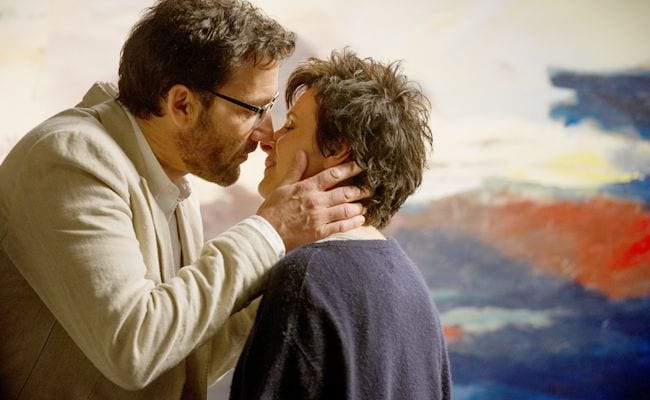
When Dina Delsanto (Juliette Binoche) walks into the teacher’s lounge at her new place of employment, a high-society preparatory school, the boozy and freestyling English teacher Jack Marcus (Clive Owen) notices her right away. Though she is reserved and distant, Jack makes an attempt at a flirtatious introduction. When she tells him she will be teaching an honors art class, he quips, “Hence the scarf.” Though he is a stronger personality, she doesn’t let him get the best of her; when he says he is an English teacher, she quips back, “Hence the hence.”
Such witty barbs are peppered throughout Words and Pictures. The success of this playful banter is due to Binoche and Owen’s remarkable chemistry as much as it is to Gerald Di Pego’s script. Binoche’s introverted rage is met perfectly by Owen’s sly gregariousness. (Owen’s role here is basically a contemporary update of his portrayal of Ernest Hemingway in the HBO film Hemingway & Gellhorn.)
This repartee is seriously needed, too, because the basic premise of Words and Pictures is so outright ridiculous that the only thing that saves it from becoming a totally forgettable rom-com is the success of its actors. The film requires the absolute best out of Binoche and Owen, and although neither performance will have anyone speculating about potential awards, the undeniable charm of the pair does give the story much needed vitality.
As the name Words and Pictures implies, the conflict that Di Pego and director Fred Schepisi use as the central framing devices is one between two artistic mediums. On her first day at the fancy preparatory school, Dina tells her art students, “Words are lies; words are traps.”
Though her intent is to use a provocation to inspire her art students towards greatness, when her view of the written word gets around, Jack starts up a feud. The two agree to have a competition between “words and pictures”, to culminate in a large school forum wherein students vote on which method of making art is superior.
Ostensibly, Jack and Dina are serious academics. Though he hasn’t been published in several years, Jack is a writer and poet of some repute. Dina is a highly renowned artist, who is only held back from pursuing her work to its fullest extent by her debilitating rheumatoid arthritis (RA), which has progressed to so severe a stage that at times she cannot even change her clothes without assistance. In spite of their academic chops, however, both Jack and Dina fully commit themselves to what is an outrightly silly ideological battle, one that, in the first place, isn’t much of a battle.
The value of art and the value of literature are subjects scholars the world over have written innumerable volumes about, but rarely, if ever, do they devolve to, “Words are better!” “No, pictures are better!” Indeed, the film itself ends up recognizing this in the end, when at the final “Words vs. Pictures” assembly at the school, no vote is taken for which side won. Jack instead gives an erudite speech that exults the value both of literature and of visual art. Big surprise: words and pictures aren’t mutually exclusive ventures.
Of course, despite its presence as a key framing device, the “battle” between words and pictures is less about a judgment of aesthetic paradigms but instead the troubled lives of Jack and Dina. (And, as Jack notes, a way of getting the students’ competitive drives up so as to get them more involved in the classroom.) One of the many reasons why Jack hasn’t written in years is due to his failed marriage and boorish alcoholism.
He tries to be a charming drunk (“It’s a hobby”, he tells a concerned restaurant manager), but, as it usually happens, what he perceives as charm comes off instead as uninvited cantankerousness. It’s no wonder his son keeps avoiding his calls.
Dina, meanwhile, has bottled up the anger she has stemming from her RA. She is able to paint with the assistance of an arm brace and various suspension devices that allow her to hang in the air while painting, but she nonetheless feel as if her body is constricting who she truly is. Her students see her as stringent and severe, but her methods have largely to do with her trying to bring out the greatness in others that she once saw in herself. This “tough love” method is one that ends up working on many of her students; however, she certainly doesn’t make friends with everyone in doing so.
The battle between words and pictures, then, ends up not being the battle it is at first set out to be. This duel is really a proxy conflict fought by people who, by internalizing their worst flaws, hold themselves back from expressing what they truly feel. In choosing to bury themselves in a battle so outrightly cartoonish, Jack and Dina reveal their stunted emotional states. They fail to see that reconciliation lies right in front of them.
While the construction of Words and Pictures is far too trifling to take seriously, Binoche and Owen give it their best, and as a result they elevate what otherwise would have been an outlandish premise into a fairly pleasurable affair. Watching the two of them flirt and bicker is both pleasing to the ear and the eyes: words and pictures, working together.
Included on the DVD are a few extras, including a serviceable but otherwise unremarkable making-of featurete.


![Call for Papers: All Things Reconsidered [MUSIC] May-August 2024](https://www.popmatters.com/wp-content/uploads/2024/04/all-things-reconsidered-call-music-may-2024-720x380.jpg)



